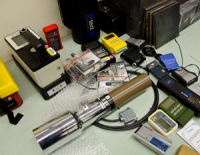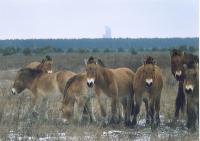-
Demonstrating technologies for disaster response
Radiological incidents such as Chernobyl and Fukushima illustrate the need for effective coordination of federal, state, and local agencies in response efforts. Earlier this year, the Department of Homeland Security (DHS) Science and Technology Directorate’s (S&T) National Urban Security Technology Laboratory (NUSTL) and the Environmental Protection Agency (EPA) demonstrated new technology developments at the Columbus, Ohio, Battelle Memorial Institute facility that will enable more effective radiological decontamination.
-
-
Surface Enhanced Raman Scattering (SERS) technology for on-site detection
Surface Enhanced Raman Scattering (SERS) technology currently is applied using chemical analysis of materials, such as scanning at airports to identify what materials may be inside of glass vials. Researchers want to expand SERS for use in biological applications that could employ antibodies for purposes such as identifying viruses, water toxins, or pathogens in food samples. The researchers work on developing a small hand-held device that allows users to take a sample, put it in a glass vial and insert into the instrument for rapid identification.
-
-
Finnish company to construct final disposal facility of spent nuclear fuel

The Finnish government has granted a license to Finnish company Posiva for the construction of a final disposal facility for spent nuclear fuel. The spent fuel assemblies will be encapsulated and placed in the bedrock at a depth of about 400 meters for permanent disposal. The waste will be stored for around 100,000 years before its level of radioactivity begins to dissipate. “This is the world’s first authorization for the final repository of used nuclear waste,” Finland’s Economy Minister Olli Rehn said.
-
-
New, portable radiological detectors for frontline personnel

Recently, DHS’s Domestic Nuclear Detection Office (DNDO) awarded a multimillion dollar contract which will equip U.S. Coast Guard (USCG), U.S. Customs and Border Protection (CBP), and Transportation Security Administration (TSA) frontline personnel with a new capability to detect and interdict radiological or nuclear threats. The award is for small, wearable radiation detector devices – called Human Portable Tripwire (HPT) — which passively monitor the environment and alert the user when nuclear or other radioactive material is present.
-
-
Inspired by cats’ eyes, new camera can look inside nuclear reactors

Currently 11 percent of electricity worldwide is generated by nuclear reactors. There are 435 reactors in operation with another 71 under construction. Engineers, drawing inspiration from the eyes of cats, have created a new camera that can see radiation coming from nuclear reactors — boosting safety, efficiency, and helping during nuclear disaster emergencies.
-
-
Search in Illinois, Indiana for missing canister holding radioactive materials
Teams from the Illinois Emergency Management Agency (IEMA) are continuing their search in Illinois and neighboring Indiana for a missing steel canister containing radioactive material. The locked steel canister was last believed to be in a custom oil well logging truck. The nuclear material was used by an Illinois company specializing in surveying oil wells.
-
-
Residents of a St. Louis suburb worry about landfill containing nuclear waste
Residents of a St. Louis suburb are increasingly anxious over a potential nuclear threat buried in the ground. One landfill nearby contains nuclear waste, while in a second landfill, only 1,000 feet away, there is “hot spot” burning underground. There are other problems, though. Over the past weekend, a grass fire reached to within seventy-five yards of the radioactive waste, and the region sits near an earthquake fault line.
-
-
$100 million NIAID contract to SRI International to develop radiation exposure treatment

SRI International has been awarded a resource contract of up to $100 million over five years by the National Institute of Allergy and Infectious Diseases (NIAID), part of the National Institutes of Health, for the development of products to mitigate or treat acute or delayed effects of radiation exposure.
-
-
Steam thermography may compete with luminol in solving crimes
Luminol gets trotted out pretty frequently on TV crime shows, but a new technique might someday compete with the storied forensics tool as a police procedural plot device and, perhaps more importantly, as a means of solving real crimes. Researchers developed what they term “steam thermography,” which has the ability to detect blood spots in all kinds of spots — even in spots where luminol cannot.
-
-
U.S. to clean up site of a 1966 nuclear weapons accident in Spain
On 17 January 1966, a B-52 bomber carrying four hydrogen bombs collided with a KC-135 tanker plane during mid-air refueling off the coast of Almería, Spain, killing seven of the eleven crew members. Two of the bombs were recovered intact from the sea, but the other two leaked radiation into the surrounding countryside when their plutonium-filled detonators went off, strewing 3kg of radioactive plutonium 239 around the town of Palomares. Following the accident, the U.S. military shipped 1,700 tons of contaminated soil to South Carolina, and the whole thing was forgotten. On Monday in Madrid, Secretary of State John Kerry and the Spanish foreign minister José Manuel García-Margallo, signed an agreement to clean up the site after tests showed that 50,000 cubic meters of soil were still contaminated.
-
-
Developing nuclear cladding to withstand Fukushima-like meltdown conditions
Like much of the rest of the world, thousands of scientists and engineers watched in March 2011 as Japan’s Fukushima Daiichi nuclear reactors exploded. The fuel’s cladding, a zirconium alloy used to contain the fuel and radioactive fission products, reacted with boiling coolant water to form hydrogen gas, which then exploded, resulting in the biggest nuclear power-related disaster since Chernobyl. Challenged by this event, two research teams have made progress in developing fuel claddings that are capable of withstanding the high temperatures resulting from a Loss of Coolant Accident (LOCA), like that at Fukushima.
-
-
Researchers develop rapid method for water, air, and soil pathogen screening
Researchers have developed a highly sensitive, cost-effective technology for rapid bacterial pathogen screening of air, soil, water, and agricultural produce in as little as twenty-four hours. “Rapid and reliable pathogen detection in field samples is critical for public health, security and environmental monitoring. Current methods used in food, water or clinical applications rely on labor and time-intensive culturing techniques while activities such as dairy farming, wastewater and runoff treatment necessitates real-time monitoring of pathogens in environment samples,” said one of the researchers.
-
-
Water security test bed to focus on bolstering municipal water security
Water is the foundation for life. People use water every single day to meet their domestic, industrial, agricultural, medical, and recreational needs. After the September 2001 terrorist attacks, water system security became a higher priority in the United States. The Water Security Test Bed (WSTB) at Idaho national Laboratory can be used for research related to detecting and decontaminating chemical, biological, or radiological agents following an intentional or natural disaster. The WSTB will focus on improving America’s ability to safeguard the nation’s water systems, and respond to contamination incidents and to natural disasters.
-
-
FBI helps foil several plots to sell nuclear material in Moldova’s black market
Over the past five years, four attempts by Russian gangs in Moldova to sell nuclear material have been thwarted by the FBI and Moldovan authorities. The most recent case was in February when a smuggler, who specifically sought a buyer from Islamic State, offered undercover agents a large amount of radioactive caesium. The would-be smuggler wanted €2.5 million for enough radioactive material to contaminate several city streets.
-
-
Animals have returned to Chernobyl

In 1986, after a fire and explosion at the Chernobyl Nuclear Power Plant released radioactive particles into the air, thousands of people left the area, never to return. Now, researchers have found that the Chernobyl site looks less like a disaster zone and more like a nature preserve, teeming with elk, roe deer, red deer, wild boar, and wolves. The findings are a reminder of the resilience of wildlife.
-
More headlines
The long view
Keeping the Lights on with Nuclear Waste: Radiochemistry Transforms Nuclear Waste into Strategic Materials
How UNLV radiochemistry is pioneering the future of energy in the Southwest by salvaging strategic materials from nuclear dumps –and making it safe.
Model Predicts Long-Term Effects of Nuclear Waste on Underground Disposal Systems
The simulations matched results from an underground lab experiment in Switzerland, suggesting modeling could be used to validate the safety of nuclear disposal sites.
